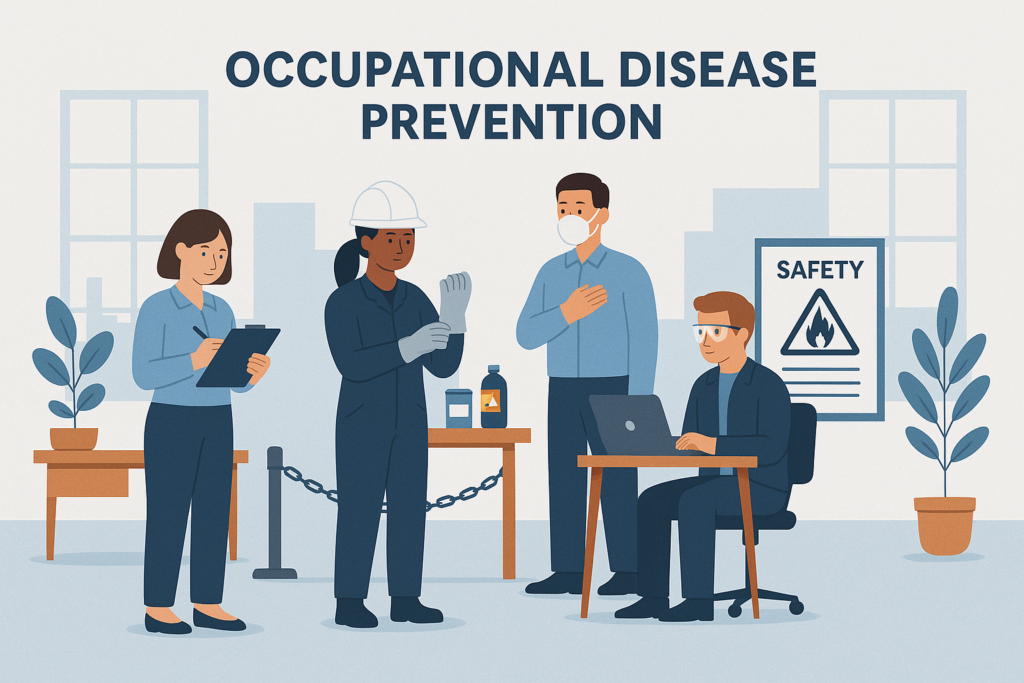5 pillars of occupational health : Occupational health is more than a compliance requirement—it’s the heart of a productive, resilient, and ethical work environment. At its core are five fundamental pillars that support the well-being of workers and drive sustainable performance across all industries.
These pillars work together to prevent workplace injuries, manage health risks, and promote a culture where safety and wellness are embedded in everyday operations.

This article explores the 5 pillars of occupational health and why integrating them into your organization is critical to long-term success.
- 5 pillars of occupational health
- 1. Health Surveillance and Risk Assessment
- 2. Workplace Health Promotion
- 3. Occupational Disease Prevention
- 4. Health and Safety Training
- 5. Legislation and Compliance
- Why the 5 Pillars Matter More Than Ever
- Internal Links for Further Reading
- Conclusion: Embrace the 5 Pillars of Occupational Health
5 pillars of occupational health
1. Health Surveillance and Risk Assessment
Health surveillance is the systematic monitoring of workers’ health to identify early signs of occupational diseases or adverse effects. It involves regular check-ups, biological monitoring, and health questionnaires, especially in high-risk industries like mining, construction, and healthcare.
Paired with risk assessment, this pillar helps organizations proactively identify and control health hazards such as:
- Exposure to hazardous chemicals
- Noise-induced hearing loss
- Respiratory diseases from dust or fumes
- Musculoskeletal disorders due to repetitive tasks
Risk assessments must be dynamic, reviewed regularly, and involve all stakeholders. The goal is prevention—intervening before harm occurs.
Internal Link: Learn more about effective hazard identification techniques.
2. Workplace Health Promotion
Beyond preventing illness, occupational health is about enhancing employee well-being.

Workplace health promotion includes strategies that support mental, physical, and emotional wellness:
- Encouraging regular physical activity through wellness programs
- Offering healthy food options and hydration stations
- Promoting mental health through stress management workshops and access to counseling
- Supporting work-life balance with flexible work arrangements
These initiatives improve morale, reduce absenteeism, and foster a more engaged workforce.
External Resource: World Health Organization: Workplace Health Promotion (DoFollow)
3. Occupational Disease Prevention
Occupational diseases can be silent and long-developing, such as asbestosis, silicosis, or carpal tunnel syndrome. Preventing them requires a layered approach:
- Education and training on recognizing symptoms and using protective measures
- Elimination or substitution of hazardous substances
- Engineering controls like ventilation and noise insulation
- Proper use of Personal Protective Equipment (PPE)
A strong OHSE management system ensures that preventive measures are documented, followed, and regularly reviewed.

4. Health and Safety Training
One of the most effective ways to reduce workplace injuries is through consistent, high-quality health and safety training. It empowers employees with the knowledge and skills to:
- Recognize hazards
- Use PPE effectively
- Respond to emergencies
- Follow safe work practices and procedures
Training should be task-specific, language-appropriate, and ongoing. It’s not a one-time activity but an evolving process that adapts to new risks and regulations.
External Resource: Canadian Centre for Occupational Health and Safety (CCOHS) (DoFollow)
5. Legislation and Compliance
The final pillar holds the entire occupational health structure accountable. Compliance with legislation and standards is non-negotiable for legal, ethical, and operational reasons.
Depending on the country or region, regulations may include:
- WHMIS (Workplace Hazardous Materials Information System)
- OSHA (Occupational Safety and Health Administration – USA)
- ISO 45001 for occupational health and safety management systems
- CSA Standards (Canada)
- Provincial OH&S Acts and regulations

Compliance ensures that organizations:
- Conduct regular inspections
- Maintain proper documentation
- Report incidents promptly
- Provide mandatory training and protective equipment
Falling short can result in fines, legal liabilities, and reputational damage—not to mention harm to workers.
Why the 5 Pillars Matter More Than Ever
In a fast-changing world—with new technologies, evolving work models, and increasing awareness of mental health—occupational health must be adaptive.
Organizations that embrace the 5 pillars of occupational health don’t just meet standards—they cultivate trust, reduce turnover, and increase productivity.
These pillars create a workplace where:
- Employees feel valued and protected
- Hazards are addressed before they become incidents
- Wellness is promoted alongside performance
- Legal risks are minimized
In essence, they form the backbone of a resilient and future-ready business.
Internal Links for Further Reading
- Explore how to build a safety culture in your organization.
- Read our article on psychosocial risks in the workplace.
- Discover tools to enhance employee engagement.
Conclusion: Embrace the 5 Pillars of Occupational Health
Integrating the 5 pillars of occupational health into your operations is not a luxury—it’s a necessity. From proactive risk assessments to employee wellness initiatives and legal compliance, these pillars support a comprehensive, preventive, and people-first approach to workplace safety.

Whether you’re a safety manager, HR professional, or executive leader, embracing these pillars will help you build a thriving and responsible workplace.

No comments yet